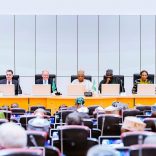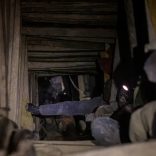Displaced Sudanese stream home from Egypt after army retakes Khartoum
Rwanda’s credit outlook shifted to negative by Moody’s, B2 ratings affirmed

File photo: Reuters
Moody’s Ratings has revised the outlook for the Government of Rwanda from stable to negative, while affirming the long-term local and foreign currency issuer ratings and foreign currency senior unsecured debt rating at B2.
The adjustment to a negative outlook is a reflection of the risks to Rwanda’s credit profile due to the ongoing conflict in the eastern provinces of the Democratic Republic of Congo (DRC). Despite diplomatic efforts to ease tensions, including a meeting between the presidents of Rwanda and DRC in Qatar on March 18, 2025, the situation remains difficult due to the territory captured and continued advances by the M23 rebels.
Rwanda faces potential risks from a withdrawal of external financial support or a steep drop in tourism revenue. While these risks are not part of Moody’s baseline scenario, they have become more significant due to growing pressure from the international community. Some bilateral support to Rwanda has recently been suspended, though it has been limited so far. The country’s high foreign currency denominated debt burden heightens its vulnerability to a significant reduction in foreign exchange inflows.
The affirmation of the B2 rating is supported by Moody’s baseline expectation that the hostilities in eastern DRC will not significantly escalate, diplomatic efforts will continue, and Rwanda will continue to receive support from development partners. The B2 rating reflects Rwanda’s small and low-income economy, which is vulnerable to shocks, and its high government debt burden and exposure to challenging regional geopolitics. However, the country’s solid institutions and governance, strong growth prospects, and limited liquidity risk due to its debt structure being skewed toward low-cost financing from the official sector provide a level of resilience.
Rwanda’s local and foreign currency country ceilings remain unchanged at Ba2 and B1, respectively. The three-notch gap between the local currency ceiling and the sovereign rating balances relatively predictable and reliable institutions with a proven record of policy execution, against the government’s large footprint in the economy, the persistent regional geopolitical challenges it faces, and the country’s structural external vulnerability in the form of large current account deficits. The two-notch gap between the foreign currency ceiling and local currency ceiling takes into consideration Rwanda’s reliance on external debt financing, albeit from stable sources, and the limited currency flexibility that raise the risk of transfer and convertibility restrictions being imposed.
The ongoing conflict in eastern DRC poses significant risks to Rwanda’s credit profile as it could continue to intensify geopolitical tensions. For Rwanda, a significant withdrawal of financial support – particularly from multilateral development partners – is a key risk channel. Bilateral support has already tapered amid geopolitical tensions, likely costing 0.7% of revenue or 0.2% of GDP in the coming fiscal year. However, Rwanda’s multilateral support is far more critical, accounting for about 60% of grants (or 0.6% of GDP) and 85% of low-cost loans from the official sector and 60% of total government debt.
Another risk channel for Rwanda’s credit profile is through a material reduction in tourism revenue, were the situation in eastern DRC to prompt tourism warnings in origin countries and deter tourist arrivals. Tourism revenue represented around 5% of GDP in 2024, while the sector remains a key growth driver, jobs creator and foreign exchange generator. Significant investments with the new Bugesera airport are under way to leverage further the growth opportunity from the country’s attractiveness as a destination for ecotourism and large events requiring a safe and efficient operating environment.
Rwanda’s high debt burden, which reached 77% of GDP at the end of 2024 and of which 82% is denominated in foreign currency, exacerbates its exposure to a significant reduction in foreign exchange inflows stemming from the downside risks. Were such a reduction in multilateral financial support or tourism revenue to occur, the government’s ability to manage the resulting decrease in foreign exchange proceeds would likely be constrained.
The affirmation of the B2 rating is based on the assumption that the hostilities in eastern DRC do not escalate significantly, diplomatic efforts to de-escalate tensions will continue, and that Rwanda will continue to receive support from development partners. Rwanda’s B2 rating reflects its small and low-income economy that is vulnerable to shocks, a high government debt burden and challenging regional geopolitical developments.
Rwanda’s exposure to environmental risks is driven mainly by its physical climate vulnerability. Periods of droughts and flooding can affect the output and income earned by the sizable portion of the economy employed in the agriculture sector, and result in inflationary pressures and increased poverty. The country’s exposure to social risks is mainly related to high levels of poverty and unemployment. Access to basic services outside of the urban areas also remains limited. These challenges are exacerbated by the still relatively poor physical infrastructure in rural areas that will take a long time to develop because of the country’s terrain.
The negative outlook signals that a rating upgrade would be unlikely in the near term. The outlook would likely be changed to stable if the risk of further intensification in the conflict in eastern DRC receded. Longer term, Rwanda’s ratings could be upgraded if effective implementation of the government’s fiscal reforms, including its medium-term revenue raising strategy, puts its debt burden on a downward trend. A downgrade of Rwanda’s ratings would be likely if the ongoing conflict in eastern DRC were to significantly impair the government’s access to external, concessional financing.













Leave a Reply
Be the First to Comment!
You must be logged in to post a comment.
You must be logged in to post a comment.